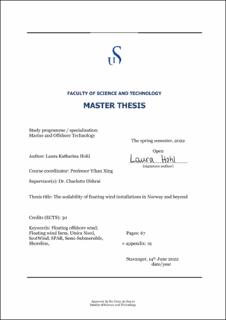| dc.description.abstract | Offshore wind energy has recently become a big industry in many countries [89]. However, offshore
floating is still at the beginning of its commercial use, and the number of projects under
development has increased. Future offshore wind projects are expected to increase in size, using
wind turbines with larger design capacities, be in deeper waters, and further offshore. As a
result, ports need to be modified to handle the larger turbines and substructures [33, 6]. The
North Sea has great potential for offshore wind parks in intermediate deep waters; therefore,
many projects are planned in this area. However, this study focuses on developing an offshore
wind park with turbines mounted on a spar substructure. In particular, this thesis investigates
the development of the Utsira Nord project in Norwegian waters with Wergeland base as an assembling
base and gives a short outlook of a project area in Scottish territories.
Different parameters such as storage capacity, scaling up infrastructure in terms of the number
of cranes and vessels, and shift rotation has been analyzed and compared. Further, the size
of the wind turbine has been scaled up, as well as the installation from different ports for two
different sites. Analysis showed that the crane has a major influence on the costs, and its usage
should therefore be reduced to a minimum. Having sufficient storage capacity is essential for
the efficient usage of the crane. However, in our simulations, crane and storage capacity did
not influence the completion time significantly. Similar reductions in the completion time can
be obtained by using more or faster tug and anchor handling vessels (AHV), but using more
vessels did increase the cost. Having more tugs is more profitable in combination with an increased
storage capacity. Nevertheless, using faster tugs gives an improved cost-benefit when
a smaller storage capacity is available. When comparing the installation for a site from two different
ports, it was assumed that both ports have the same infrastructure. The port closest to
the project site has a big advantage as the installation from that port takes less time due to the
lower transit times. However, it is important to note that the port in Scotland does not have deep
water close to shore or the same crane and storage space that Wergeland Base has in Norway.
Norway’s unique geography means that we have deep water and sheltered wave conditions that
are ideal for the assembly of deep and shallow draft floating wind turbines. | |
